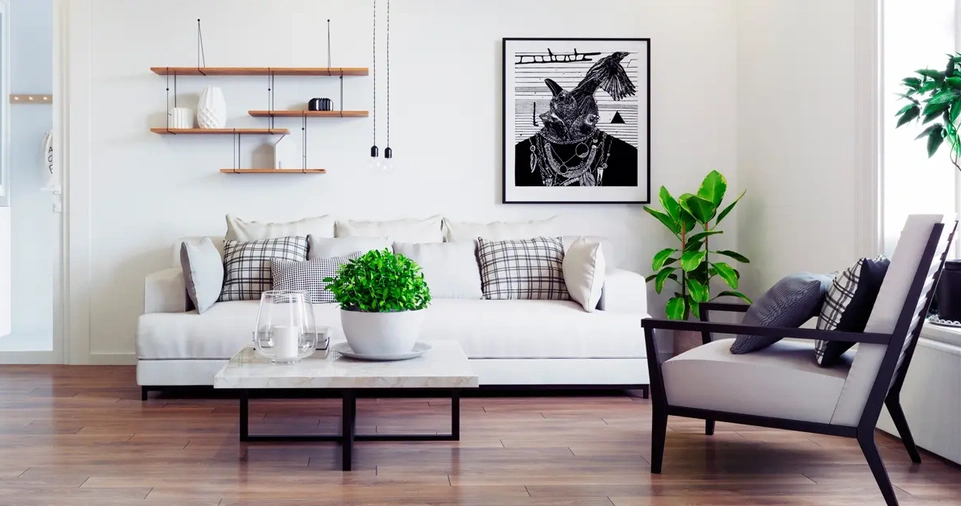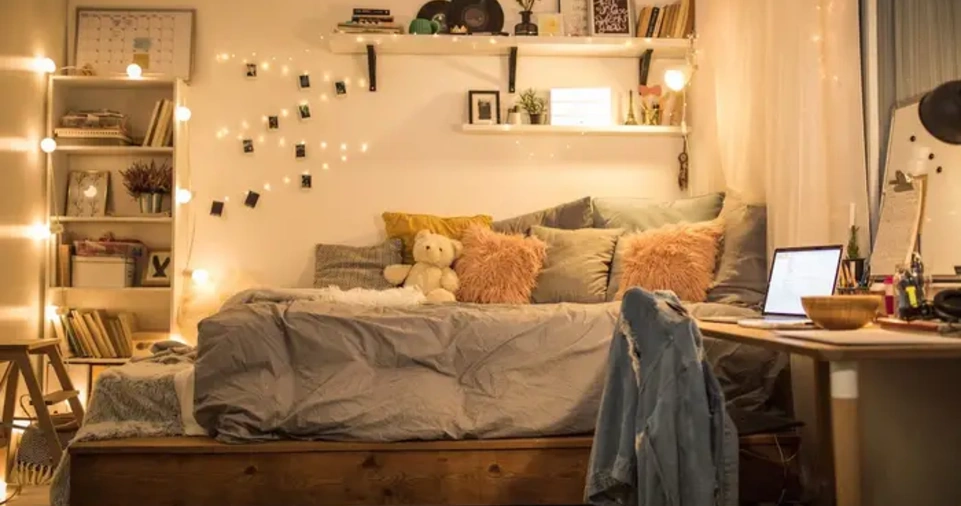Make Your Home Feel More Spacious is a common concern for many homeowners and renters alike.
Whether you’re working with a small apartment or a compact house, creating the illusion of more space can transform the way you feel about your home.
By strategically applying design principles and smart organization techniques, you can maximize your available space without the need for major renovations.
This guide covers effective methods, from utilizing light colors and multi-functional furniture to optimizing layout and storage solutions.
With these proven tips, you’ll learn how to enhance the flow and atmosphere of any room, making your home feel more open, airy, and inviting.
Embrace Minimalism
One of the most effective ways to make your home feel more spacious is to adopt a minimalist lifestyle.
That means getting rid of items you don’t need and focusing only on essentials that serve a purpose.
Tips to embrace minimalism:
- Remove unnecessary furniture
- Keep countertops clear
- Limit the number of decorations or accessories
- Store items out of sight
By minimizing clutter and focusing on simplicity, your space will feel larger, cleaner, and more breathable.
Use Light Colors and Neutral Palettes
Color has a significant impact on how we perceive space. Dark or bold colors can make a room feel cozy but also smaller. On the other hand, light and neutral tones can reflect light and give the illusion of a larger area.
Color suggestions:
| Room | Recommended Colors |
|---|---|
| Living Room | Soft whites, beige, pale gray |
| Kitchen | Light mint, white, light yellow |
| Bedroom | Sky blue, soft lavender, pastel pink |
| Bathroom | Light aqua, cream, light taupe |
Pro Tip: Use the same color on your walls and ceiling to blur boundaries and make the room feel taller.
Utilize Multi-Functional Furniture

Investing in multi-purpose furniture can help you reduce clutter and make more efficient use of your space.
Examples of multi-functional furniture:
| Furniture Piece | Functionality |
|---|---|
| Sofa bed | Seating + sleeping |
| Ottoman with storage | Footrest + hidden storage |
| Extendable dining table | Fits small or large gatherings |
| Wall-mounted desk | Workspace + space-saving |
Opting for furniture that can serve multiple purposes allows you to reduce the number of items in a room without sacrificing functionality.
ALSO READ: How to Drink More Water Without Thinking About It?
Rearrange Furniture for Better Flow
Sometimes, the problem isn’t the size of your home—it’s the layout. Poor furniture placement can make a space feel cramped and awkward.
Rearrangement tips:
- Avoid blocking pathways or windows.
- Keep furniture away from walls to create breathing space.
- Arrange seating in a way that promotes conversation and openness.
- Use smaller pieces instead of bulky ones in tight areas.
Even a minor change in layout can make a significant difference in how your home feels.
Let Natural Light In
Natural light instantly makes any space feel bigger, brighter, and more inviting. Maximize the amount of sunlight coming into your home by:
- Avoiding heavy or dark window treatments
- Using sheer curtains or blinds
- Keeping windows clean and unobstructed
- Placing mirrors near windows to reflect light
If natural light is limited, consider daylight-style bulbs and layered lighting with floor and table lamps.
Install Mirrors Strategically
Mirrors can create the illusion of depth and make a small room appear much larger. They reflect light and views, which tricks the eye into thinking there’s more space.
Where to place mirrors:
| Room | Mirror Placement Tip |
|---|---|
| Living Room | Behind a light source to double brightness |
| Bedroom | Across from a window to reflect natural light |
| Entryway | Opposite the door to create an open feel |
| Hallway | Along narrow walls to widen the space |
Oversized mirrors or mirrored furniture pieces can amplify the spacious effect.
Declutter and Organize Effectively

A tidy, well-organized space always feels bigger than a messy one. Decluttering is essential if you want to maximize your living area.
Decluttering tips:
- Follow the “one in, one out” rule.
- Use storage boxes or baskets to contain items.
- Store seasonal items out of sight.
- Donate, sell, or discard anything you haven’t used in the last year.
A well-organized home not only feels larger but also promotes mental clarity.
ALSO READ: How to Prep Meals Ahead of Time: A Complete Guide to Efficient Meal Planning
Take Advantage of Vertical Space
When you’re short on horizontal room, look up. Using vertical space helps keep your floor area clear and creates the perception of height.
Ideas to use vertical space:
- Install tall bookshelves or floating shelves
- Hang plants from the ceiling
- Use tall cabinets for storage
- Mount your TV on the wall
The goal is to free up the floor and draw the eye upward, which makes rooms feel taller and more expansive.
Choose the Right Flooring
Flooring can make a big difference in how large a room feels. Continuity is key—consistent flooring throughout a space helps to unify areas and reduce visual breaks.
Best flooring for a spacious feel:
| Flooring Type | Advantage |
|---|---|
| Light wood or laminate | Reflects light and adds warmth |
| Large tiles | Fewer grout lines for a seamless look |
| Vinyl planks | Budget-friendly and space-enhancing |
| Polished concrete | Modern and visually expansive |
Avoid rugs that break up visual flow unless you’re using them for zoning.
Incorporate Built-In Storage Solutions
Built-in furniture and storage offer a sleek, space-saving way to keep clutter at bay without sacrificing floor space.
Examples include:
- Built-in bookshelves
- Under-stair storage
- Wall niches for décor or shelving
- Window seat with hidden storage
Built-ins are ideal because they’re flush with the wall, reducing bulk and increasing usable space.
Use Curtains and Rugs Wisely
Heavy, dark curtains and small rugs can break up the visual flow of a room. Choose treatments that support the feeling of openness.
Tips:
- Hang curtains higher than the window to make ceilings feel taller.
- Use light, airy materials like linen or cotton.
- Choose rugs large enough to anchor furniture without crowding the room.
- Avoid bold patterns that make spaces feel busy.
Soft, light fabrics help the eye move freely and make the room feel calm and expansive.
Zone Your Space with Purpose

Open-concept homes can sometimes feel chaotic without clear boundaries. Use furniture, rugs, or lighting to define different zones while maintaining a cohesive feel.
Examples of zoning:
| Zone | Divider Option |
|---|---|
| Living area | Area rug or sectional sofa |
| Home office | Bookshelf or folding screen |
| Dining area | Pendant lighting above the table |
| Reading nook | Armchair and floor lamp |
Zoning helps you maximize function without closing off the space.
Create Visual Continuity
Consistent colors, materials, and design elements throughout your home help create a seamless, expansive feel.
How to create continuity:
- Stick to a cohesive color palette
- Use matching or complementary furniture styles
- Carry similar finishes (e.g., chrome, wood tones) across rooms
- Keep flooring consistent between spaces
When your eye flows smoothly from room to room, it gives the impression of a more open layout.
Keep Decor Simple and Cohesive
Decor is important, but too many accents can make your home feel cramped. Choose a few key pieces that complement your space.
Decor tips:
- Use larger statement pieces instead of many small ones
- Opt for wall-mounted décor to keep surfaces clear
- Choose glass or acrylic items to maintain transparency
- Group similar objects to reduce visual clutter
Intentional, well-spaced décor enhances your home’s aesthetic while maintaining an open feel.
ALSO READ: How to Teach Kids About Responsibility?
Conclusion
Making your home feel more spacious isn’t about knocking down walls or doing expensive renovations.
It’s about being strategic with what you have—maximizing light, minimizing clutter, choosing functional furniture, and creating visual harmony.
Whether you’re living in a studio apartment or a modest family home, these design tips and organizational techniques can transform your space into a more open, inviting, and peaceful environment.







